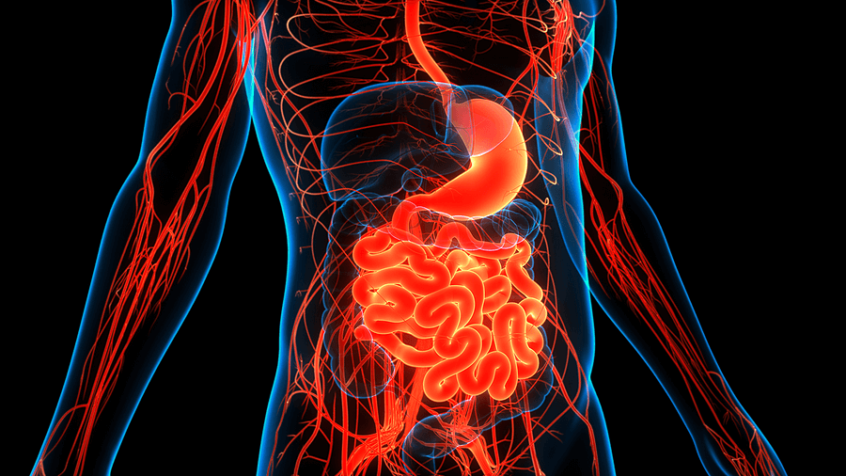Adapted from Pointe Institute, The Standard, Volume 17, Number 1, 2021 by Thomas G. Guilliams, PH.D. and Lindsey E. Drake, M.S.
Gut health isn’t just about the gut! The functional medical community has discussed the connection of microbiome gut health to systemic health challenges for quite some time. The presence or absence of certain microbes (bacteria), or the overpopulations of microbes, can lead to cardiometabolic, autoimmune, obesity, or other chronic diseases. This series will highlight the overpopulation of microbes known as SIBO.
What is SIBO?
SIBO, small intestinal bacterial overgrowth, is often associated with chronic gastrointestinal symptoms, though not always. It’s possible to have SIBO without symptoms. But when associated with the GI, people experience symptoms such as gas, bloating, and abdominal pain. That may be all or SIBO may be the cause of gastrointestinal diseases such as Celiac Disease, Crohn’s Disease, IBS, and more.
SIBO has historically been described as a syndrome related to malabsorption. As information about the syndrome evolved, the term overgrowth was included to account for the increase in culturable bacteria from the small intestine. In addition to overgrowth, SIBO can often be attributed to the type of bacteria in the intestine. All along the insides of the 20-25 feet of intestines found in humans are various microbial communities in various segments – each with their own function.
The biggest question surrounding SIBO, however, is whether the SIBO is the cause of other ailments or if the other ailments cause SIBO. Research would suggest it’s likely both. But more importantly, what is the root cause of any ailment?
Diagnosing SIBO
Everyone is different but SIBO causes GI symptoms including: gas, bloating, painful distension, diarrhea and/or constipation, etc. SIBO can also be characterized by nutrient deficiencies especially the B vitamins and fat-soluble vitamins. Therefore, sometimes a diagnosis is given based on these criteria alone but more often people want testing that provides more concrete information.
One such test is a small intestinal aspirate and culture. This is a good test because it is a direct measurement of intestinal bacteria. But it is uncomfortable, invasive, and expensive so it is rarely performed. The most common test is the breath test. Breath testing is an indirect measurement of gut bacteria activity after drinking a carbohydrate substrate that ferments in the gut followed by measuring the amount of hydrogen in the breath. The problem with the breath test is the accuracy of the results; a fair number of tests result in false positives.
Keep things moving…
It makes sense that the intestines need to keep a regular cleaning schedule to prevent bacteria from congregating in areas where it shouldn’t, increasing to a population that is too numerous, or supporting unhealthy bacterial growth. This regular cleaning schedule is controlled by the MMC, migrating motor complex. The MMC follows the circadian rhythm and is most active at clearing non-digested food and nonfood residue during periods of fasting. The MMC is also somewhat influenced by hormones that signal hunger and satiety. Studies have shown that those with poor MMC function can be at greater risk for SIBO.
There are medications available that can help people with motility. But even better, there are plenty of natural remedies that can help with movement. Ginger has many benefits including being a GI stimulant. Artichoke leaf extract is another that is very effective. But when ginger and artichoke leaf extract are combined, the impact is even greater.
Acid and enzymes.
Stomach acid is the first line of defense in killing bacteria that are entering the body orally. With low stomach acid, there is an increase of survival of bacteria in the stomach that can compromise the microbiota in the small intestine. Symptoms of heartburn are far more often a sign of low stomach acid than too much stomach acid and should be given serious consideration before being given a proton pump inhibitor (common prescription acid suppressor).
The pancreas produces enzymes that aid in digestion by breaking down foods into the smallest possible particles for optimal absorption. When the pancreas fails to produce enough enzymes, foods don’t get broken down and therefore not digested as well as they should. Undigested food particles that move through the intestine feed bacteria – sometimes too much. Studies have linked an association between SIBO and chronic pancreatitis or pancreatic enzyme insufficiency.
Antibiotics and probiotics.
The most common therapy for SIBO is the use of antibiotics to reduce or eliminate the suspected overgrowth of bacteria. Antibiotics are about 50% effective when measured by a breath test, but the rate of relapse post treatment is very high. This makes sense because the use of antibiotics reduces or eliminates all bacteria, not just the ones that are bad or overgrown causing the gut to be more susceptible to bad bacteria inoculation. Treating SIBO with antibiotics does not address the root cause and it can lead to antibiotic resistance over time if used repeatedly.
On the flip side, probiotics is another common therapy for SIBO. Even though many providers are hesitant to use probiotics because they are bacteria and SIBO is bacteria overgrowth, probiotics have been shown to be safe and effective for use in treating SIBO. Improvements were seen in both the breath test and GI symptoms in a number of studies. Various single strains have been studied as well as combinations of strains all with varying degrees of efficacy. It’s noteworthy that the benefits of taking the probiotics were not sustained after probiotics were discontinued.
Diet and nutrients.
The most popular diet for treating SIBO symptoms is the FODMAP diet, which stands for fermentable oligo-, di-, monosaccharides, and polyols. This diet restricts anything that has fermentable sugars and/or fibers such as fructose, lactose, and many vegetables. This diet has been shown to be effective in reducing symptoms. Unfortunately, symptom relief does not mean the root cause has been resolved. The FODMAP diet must be followed continuously to sustain symptom relief which becomes impractical as well as nutrient deficient over time. Furthermore, a high fiber diet is supportive of good bowel movements and healthy gut flora making the FODMAP diet somewhat counterintuitive.
Since the root cause of SIBO is inflammation, the gold standard diet for reducing inflammation and healing the gut is the LEAP™ diet. The LEAP diet is formulated based on MRT® test results, patient health history, and some basic early limitations on fermentable foods. The first phases of the LEAP diet use the least inflammatory foods per the MRT test. Patients eat only the designated foods; it’s the tight restriction of all other foods that begins the gut healing process. Most patients with SIBO experience 25-75% symptom relief in just 10 days. Over time, more foods are gradually introduced allowing for patients to retain relief from symptoms, follow a sustainable diet plan, and assimilate more nutrients from their foods long-term.
One contributor to inflammation is nutrient deficiencies. As mentioned, it’s very common for those with SIBO to have fat soluble and B vitamin deficiencies. It may also be prudent to check iron levels. Early and complete repletion of deficiencies helps retain the reduction in inflammation. Many tests are available from a medical doctor or other health care practitioner to determine specific deficiencies so that dosing supplements can be done with the most accuracy. In a perfect world, eating whole foods would address deficiencies but this can take a long time and be incomplete. Taking dietary supplements is the fastest and most effective method for repletion in most cases.
What difference does it make?
Based on the information outlined in this article, all chronic diseases could be related to SIBO. And all cases of SIBO could be related to chronic disease. Either way, the root cause of either is inflammation. Testing for SIBO is poor at best and even if positive results are true, the various treatments are largely unproductive because none address the root cause – inflammation.
Except the LEAP diet. At A to Zinc Nutrition, we’ve determined that testing and diagnosing SIBO is irrelevant. It’s a hassle for our patients and doesn’t change the MRT/LEAP process, nor does it change the outcome. Regardless of whether a patient has SIBO and/or another chronic disease, the right foods and nutrients reduce inflammation and optimize the immune system with as much as a 90% improvement in symptoms in as little as 6 weeks.

